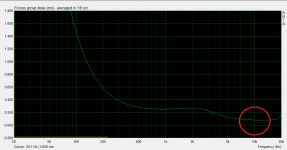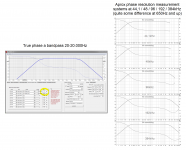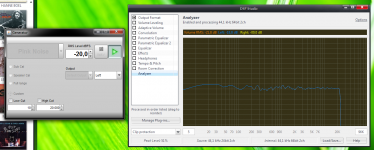I've tried to linearize the phase, but what causes that declining phase you can see on my ARTA measurements and how should I linearize it?
That declining phase is mostly time delay ( exponential profile )
To get the good phase curves in Arta, you have to enter the value
of "PreDelay (ms)", witch is time between the begining of the window and the top of the impulse.
cdt
Thanks! In this case, the pre-delay would be 3 samples, or 0,063ms?
Beginning of window is 298 samples 6.208ms and peak is 301 samples 6.271ms.
I think probably less, according to the curves:
If phase shift is -135° at 10 kHz, is gives 0,1*( 135/360) ms: 0,0375 ms
Yes but you need to choose a thinner scale before you see such small delays on screen. 100 or 200us for example, instead of the 10ms you have now.
If your xover is 2nd order around 2khz the excess gd will be around 100us + the delay embedded in your measurement.
If your xover is 2nd order around 2khz the excess gd will be around 100us + the delay embedded in your measurement.
Last edited:
Or forget about it, as I don't know anyone capable of hearing that difference...
Agree, but if you dont clear the delay embeded in the measurement you might make a wrong guess about the frequency of your xover because it will be moved at the left, 2khz instead of 2.6khz for example...If you put this wrong estimate in Rephase to linearize the phase of the xover, you will end over eq the phase, giving negative grup delay. So that i agree, befo re doing this, better do nothing...
Did some additional tries today and this is the result, which I am pretty happy with:
Now how would I go and measure reliably phase below 200hz and correct if required? If that means nearfield, how should I set predelay then?
An externally hosted image should be here but it was not working when we last tested it.
Now how would I go and measure reliably phase below 200hz and correct if required? If that means nearfield, how should I set predelay then?
Maybe you have analyzer more upstream than convolution and PEQ containers position, know you also have DATS software so i use pink-noise from their nice generator and route as in first picture. In second picture you see first left channel pure and clean signal because nothing is happening in upstream containers except that panning all signals to left channel, then below you see 310Hz EQ is turned on and analyzer reflect new boost, but in lowest analyzer window you see no EQ boost even it is still ticked on, that is because with mouse i dragged analyser container upstream up above EQ so analyzer don't see signal. So route for signal in DSP studio starts at top and we can move all containers with mouse up and down except "Output format" to get our best natural or technical strucktur. Think easy test is tick off all containers except analyser and make a screen dump with pink-noise, then tick one container on at a time make a screen dump and compare them all later to see if any flaws.
Another way to gain structure in JRiver is if you have an old unused laptop connect its I/O to computer with JRiver then install REW and you don't need to calibrate system because no matter how bad soundcard is it makes its own reference when you sweep I/O's with containers in JRiver ticked off, then tick on bandpasses and save session to study gain structure. Third picture is such a sweep with a non calibrated soundcard, red is neutral gain with containers ticked off and then the two slopes that tell woofer at very low frq is overloading red reference for DACs and mid-tweeter is close to be 12dB too low.
Try keep sample rate same in windows system and used programs plus check mixer settings is at full gain.
BYRTT,
Yet to try out your nice loopback idea. I did something similar to calibrate the soundcard when i made measurements of my setup using REW. But with level settings in REW, Jriver and input/output trims on the soundcard, i am not sure how i can get insight into the actual gain structure during regular playback. Will try it out.
I had tried to move the analyzer up and down the DSP stack with convoltion/PEQ enabled/disabled. But i havent found what causes the -20db RMS pink noise from Jriver to display almost -30db RMS on the analyzer without anything in the DSP chain.
Could you tryout -20db pink noise source from Jriver and observe the analyzer display of level?
while investigating, i actually did discover an error in my convolution cfg file, which was causing the left channel to output on both L/R speaker. Fixing that has obviously improved things, but i am still not getting the effortless mid/tweeter integration of LXmini between my W15(mid) and TF001 (tweeter)
Did some additional tries today and this is the result, which I am pretty happy with.....
.....Now how would I go and measure reliably phase below 200hz and correct if required? If that means nearfield, how should I set predelay then?
Looks good enjoy Rephase possibilities and fun, small comment is around 400Hz your phase looks start go in advance direction but then we are at trouble frq and your gate also kicks in so hard to say if anything to worry about.
A comment on linearize phase at system stop bands is we probably shall think over then our system start gets timing other than the environment original track was mixed in, but of course its free to choose ones system specs and also to try it out. Own experience pure flat phase down to DC in lows result in very track dependent outcome in some instruments get even better realism but also heard tracks where bass guitar rhythm gets too advanced in timing relative to HF rhythm cymbals. Now mostly use Rephase to neutralize phase turn from real XO points and if system haven't the real minimum phase amplitude output down to 15-20Hz, then try target a phase track that belong to a 20Hz stop band minimum phase system.
Setting other X/Y scales into Rephase below it can show how a realistic good minimum phase speaker in example a studio will perform in real world phase tracking numbers when producing the tracks we listen in everyday, the true real world phase turn above 1kHz seen in Rephase graph because of HF stop band we seldom see in home gear measurements (lack of bandwidth), plots at right show aprox what to expect for HF phase.
Attachments
Last edited:
.....while investigating, i actually did discover an error in my convolution cfg file, which was causing the left channel to output on both L/R speaker. Fixing that has obviously improved things, but i am still not getting the effortless mid/tweeter integration of LXmini between my W15(mid) and TF001 (tweeter)
Good news there discover improvement.
.....Could you tryout -20db pink noise source from Jriver and observe the analyzer display of level?.....
REW pink noise generator set at 24bit/44,1kHz -20dB (mono left ch) stream into JRiver virtual soundcard, DSP analyzer most downstream and playback is set up to use ASIO AP192.
Attachments
Last edited:
Good news there discover improvement.
REW pink noise generator set at 24bit/44,1kHz -20dB (mono left ch) stream into JRiver virtual soundcard, DSP analyzer most downstream and playback is set up to use ASIO AP192.
Thanks BYRTT, will try it out and update.
Btw, I am using rephase output as 32-bit mono .wav file.
Is there a way to use the float txt output with Jriver?
no problem, discussion on convolution engine and measurements techniques are indeed closely related to the subject herePOS, my apologies if this is drifting too far OT. Will keep it to topic.
But this setup/gain discussion of using the rePhase outputs on Jriver might be useful to new folks.
I think Jriver supports the 32bit IEEE wav format, which is equivalent to the float txt format.Btw, I am using rephase output as 32-bit mono .wav file.
Is there a way to use the float txt output with Jriver?
How do you handle volume control in your setup?
Pos,
I use internal volume setting in Jriver.
I set it fixed near the upper range around -12db.
I use Jriver PEQ to do driver level adjustments.
Based on some neat suggestions from BYRTT, i have been exploring the gain structure through the chain.
I have currently set a +9db boost on all channels again in Jriver PEQ.
But this is all still under investigation.
Final volume control is using the pot on the DAC (MOTU is using a digitally controlled analog volume control, the ESS DAC will have a 32-bit digital volume control knob)
I use internal volume setting in Jriver.
I set it fixed near the upper range around -12db.
I use Jriver PEQ to do driver level adjustments.
Based on some neat suggestions from BYRTT, i have been exploring the gain structure through the chain.
I have currently set a +9db boost on all channels again in Jriver PEQ.
But this is all still under investigation.
Final volume control is using the pot on the DAC (MOTU is using a digitally controlled analog volume control, the ESS DAC will have a 32-bit digital volume control knob)
- Home
- Design & Build
- Software Tools
- rePhase, a loudspeaker phase linearization, EQ and FIR filtering tool




